Check out the Feb. 14 edition of What’s Trending in Aerospace, where editors and contributors for Avionics International bring you some of the latest headlines and updates happening across the global aerospace industry.
Commercial
Air Canada Reports $3.8 Billion Loss in 2020 Results
Air Canada published its full-year 2020 annual results on Feb. 12, with the international carrier experiencing a $3.8 billion operating loss under the impact of COVID-19 travel restrictions.
In 2020 Air Canada’s total passenger flight operations declined by 73 percent for what CEO Calvin Rovinescu described as the “bleakest year in the history of commercial aviation.”
“Given these circumstances, we have made many painful decisions over the past year. These include reducing staff by more than 20,000, dismantling a global network ten years in the making, suspending service to many communities and aggressively cutting fixed costs. At the same time, we have bolstered our liquidity position through several debt and equity financings to allow for additional operational flexibility and to support the implementation of our COVID-19 Mitigation and Recovery Plan,” Rovinescu said. “We rationalized our fleet, accelerating the permanent removal of older, less efficient aircraft, and restructured new aircraft orders so that we will have a more fuel-efficient and greener fleet that is right-sized for the post-COVID-19 recovery period.”
According to the results, Air Canada is permanently retiring 79 older aircraft from its fleet – consisting of its Boeing 767, Airbus A319 and Embraer 190 aircraft.
New Software Solution Allows for More Complex Aviation Data Analysis
A new software solution, Flight Data Link, provided by GE Digital and Teradata will provide blended enterprise and operations data in an aviation-specific data model, according to a Feb. 11 press release.
The solution uses flight data from GE Digital’s Vent Measurement System (EMS) and Teradata’s analytic ecosystem, Vantage, according to the release. This allows flight data and operational data to be merged and complex analysis to be conducted.
“The combination of GE’s aviation experience and GE Digital’s software expertise, integrated with the world’s most robust platform for scalable analytics, allows airlines to prioritize passenger experience as well as revenue growth,” Andrew Coleman, General Manager for GE Digital’s Aviation Software group, said in a press statement. “Our deep partnership with Teradata allows us to build exciting solutions that integrate multiple data types, both from the enterprise as well as operations to drive powerful outcomes.
Business & GA
Bombardier to End Learjet Production in Fourth Quarter
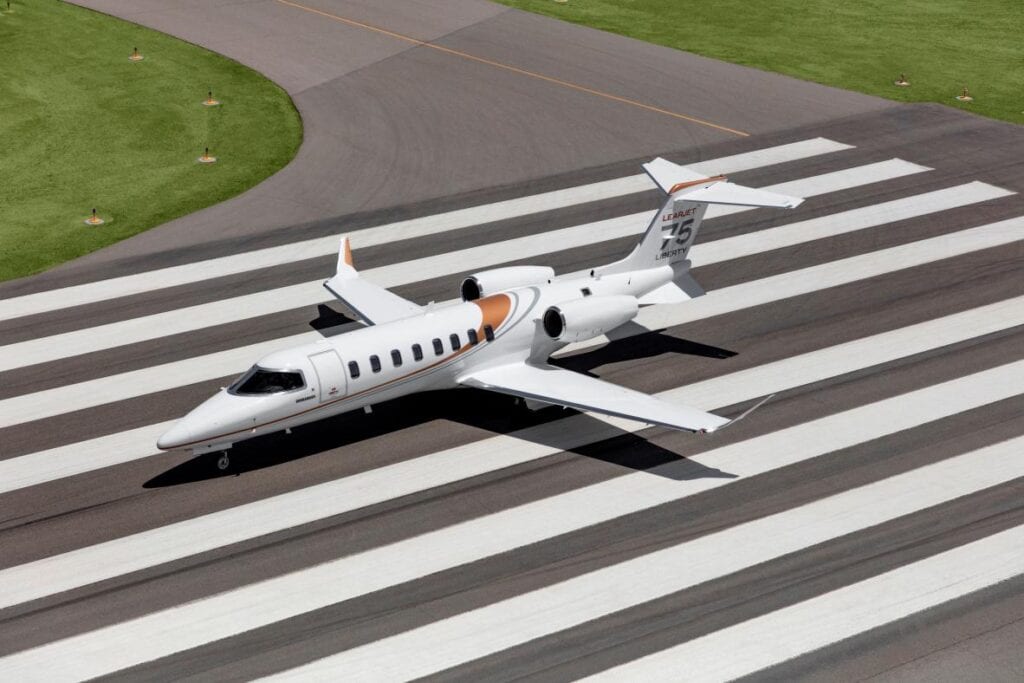
Bombardier is ending production of all Learjet aircraft models, including the Liberty 75 pictured here. (Bombardier)
Bombardier is ending the production of its iconic Learjet aircraft in the fourth quarter of 2021, according to updates provided in the Canadian business jet manufacturer’s 2020 full-year results as reported on Feb. 11.
“With more than 3,000 aircraft delivered since its entry-into-service in 1963, the iconic Learjet aircraft has had a remarkable and lasting impact on business aviation. Passengers all over the world love to fly this exceptional aircraft and count on its unmatched performance and reliability. However, given the increasingly challenging market dynamics, we have made this difficult decision to end Learjet production,” Éric Martel, President and Chief Executive Officer, Bombardier, said in a press statement.
In-service Learjet aircraft will continue to be supported into the future, under the “RACER” remanufacturing program launched by Bombardier to provide upgraded avionics, connectivity and engine enhancements for Learjet 40 and 45 aircraft that are still in operation.
Bombardier reported a total of 114 business aircraft deliveries in 2020, including 11 Learjet aircraft and 103 total combined Global and Challenger deliveries.
AEA Market Report Shows 26 Percent Avionics Sales Decrease in 2020
The Aircraft Electronics Association 2020 year-end Avionics Market Report shows over $2.2 billion in total worldwide business and general aviation avionics sales showing a 26 percent decrease from 2019 and marking the lowest amount of sales in the report’s history, according to a Feb. 9 press release.
While sales decreased in 2020 following the COVID-19 pandemic, the last six months of 2020 showed growth, according to the report.
“The last half of 2020 provided a softer landing as yearly sales totals slid back to roughly the same numbers in 2016-17,” AEA President and CEO Mike Adamson said in a press statement. “Despite the health crisis and its economic impact, I am encouraged that industry experienced steady growth during the last half of the year. Although 2020 year-end sales are significantly down from last year’s all-time high, we see positive signs in the retrofit market, which means our members are keeping busy with avionics upgrades. We are hopeful the combination of innovative new products, the resilience of consumers who continue to focus on upgrades, and an uptick in aircraft production can fuel more sales growth in 2021.”
The retrofit market and forward-fit sales made up large percentages of the $2.2 billion in sales totaling 55.9 percent and 44.1 percent respectively, according to the report.
Gulfstream Updates Its Redesign Program

(Gulfstream)
Gulfstream’s aircraft redesign program will now include more options to meet owner needs and timelines, the company announced in a Feb. 9 press release. Aircraft can now be redesigned in 30 business days.
The new program provides three update packages ranging from a refresh to a custom update, according to the release.
“From a refresh to a floorplan reconfiguration, our team can bring any vision to reality,” Derek Zimmerman, president of Gulfstream customer support, said in a press statement. “An updated aircraft not only improves the customer’s overall comfort, it can increase the aircraft’s marketability.”
Embraer E2 Aircraft Equipped with ADG-400

(Honeywell Aerospace)
A partnership between Honeywell and Embraer will equip Embraer’s E2 commercial jets with Honeywell’s Aircraft Data Gateway 400 (ADG-400) allowing the wireless transfer of critical flight and maintenance data, according to a Feb. 11 press release.
“By equipping their aircraft with Honeywell’s Aircraft Data Gateway, we’re enabling operators of Embraer regional jets to take strides toward a truly connected fleet of aircraft, which will help them keep their aircraft flying while also saving money,” Bob Buddecke, president of Honeywell Connected Aerospace, said in a press statement. “Our continued software and connectivity advancements are unlocking new ways airlines can leverage their data to improve their operations.”
The ADG-400 uses a wireless Loadable Software Aircraft Part (LSAP) loader, quick access recorder and data communications capabilities, according to the release.
“Embraer believes that fleet efficiency is significantly enhanced by the careful use of connected data,” Fernando Antonio Oliveira, vice president of Programs at Embraer Commercial Aviation, said in a press statement. “Collaboration with Honeywell on aircraft data gateways will optimize costs, which will translate into more profitable aircraft for customers.”
Military
KC-46A Pegasus Refueler for Japan Conducts Maiden Flight
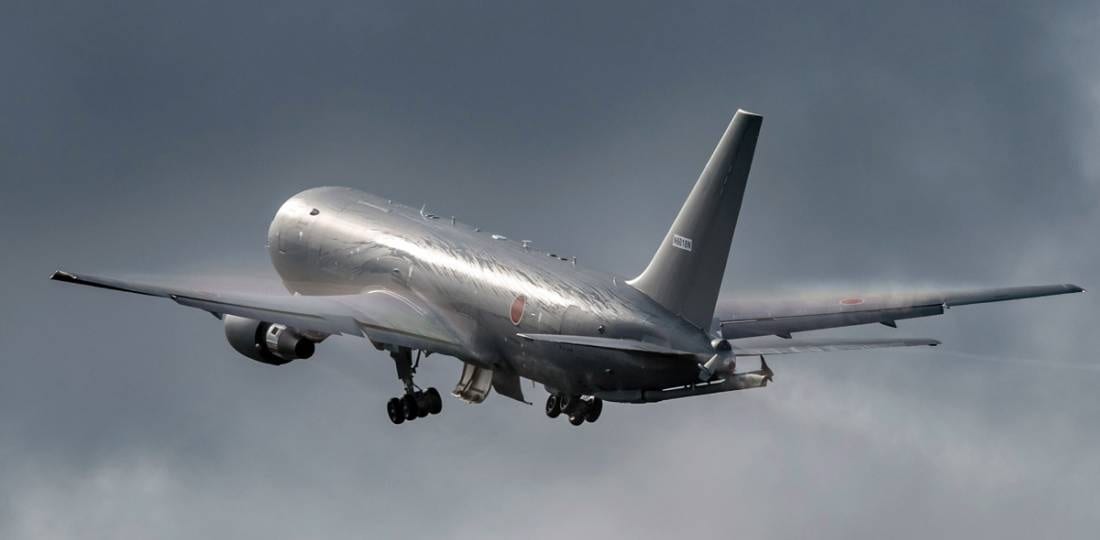
A Boeing KC-46A tanker for the Japan Air Self-Defense Force (JASDF) had its maiden flight on Feb. 8, Boeing said.
The aircraft is to be delivered to JASDF later this year and is one of four tankers for JASDF announced under a $1.9 billion deal approved under the Foreign Military Sales program by the State Department and the Defense Security Cooperation Agency in a notice to Congress in September 2016.
The refuelers are to be equipped with the Raytheon ALR-69A Radar Warning Receiver and Raytheon’s Miniaturized Airborne GPS Receiver (MAGR) 2000 (2K) to provide GPS Selective Availability Anti-Spoofing Module (SAASM) capability, and Northrop Grumman‘s AN/AAQ-24(V) Large Aircraft Infrared Countermeasures (LAIRCM) system.
Will Shaffer, president of Boeing Japan, said in a Feb. 9 statement that the KC-46 “and its robust defensive systems will play an invaluable role in the security alliance between our two countries.”
Textron’s King Air-350 Key ISR Asset For Iraqi Security Forces
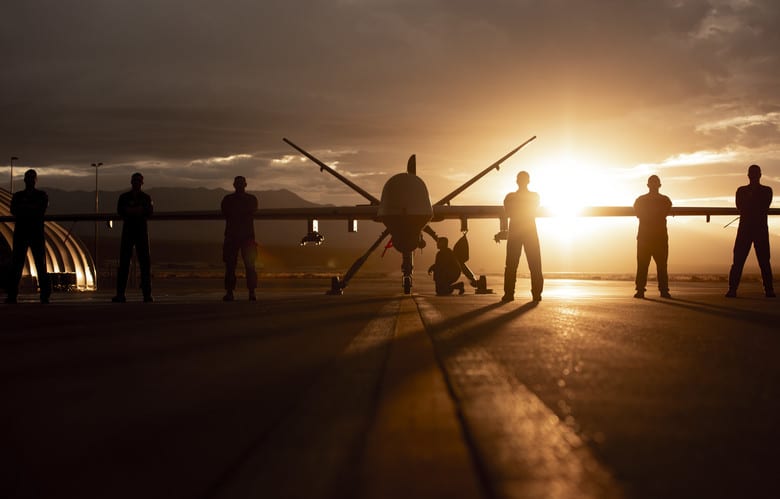
Textron‘s King Air-350 (KA-350) has been the most capable intelligence, surveillance, and reconnaissance (ISR) asset of Iraqi Security Forces (ISF), though field reports have said that it is vulnerable to jamming, according to the latest DoD Inspector General (IG) quarterly report to Congress on Operation Inherent Resolve (OIR).
The Combined Joint Task Force-Operation Inherent Resolve (CJTF-OIR) said that “the ISF is very capable of collecting and analyzing intelligence that supports targeting, especially at the operational command level,” according to the report. “However, CJTF-OIR explained that ISF intelligence collection through theater-level ISR platforms remains a shortcoming. CJTF-OIR stated that the Iraqi Air Force’s KA-350 aircraft in service is Iraq’s most capable theater-level ISR platform, but it is comparatively less capable than Coalition assets.”
Such coalition assets include the General Atomics‘ MQ-9 Reaper unmanned aircraft system. The ISF also employs 16 Boeing InSitu ScanEagle and 18 AeroVironment RQ-20 Puma ISR drones.
SAIC Receives $830 Million Deal to Continue Army Aviations Systems Engineering Work
SAIC has received a new $830 million deal from the Army to continue providing aviation systems engineering services.
The potential five-and-a-half year deal supports Army Combat Capabilities Development Command, Aviation & Missile Center (DEVCOM AvMC), Software, Simulation, Systems Engineering and Integration (S3I) Directorate and includes hardware in-the-loop (HWIL) simulation work for both manned and unmanned fixed and rotary-wing platforms.
“SAIC is privileged to support cutting-edge engineering efforts at S3I and DEVCOM AvMC along with our teammates,” Gabe Camarillo, senior vice president of SAIC’s Army business unit, said in a statement. “We look forward to extending our support to Army aviation modernization in the Huntsville, Alabama area in the years to come.”
Work on the HWIL aviation systems covers support for subsystems, testbeds, laboratories, network and support equipment, and will include concept research, design work, testing, operations and maintenance.
SAIC noted the work on this new contract will be performed under the GSA’s One Acquisition Solution for Integrated Services (OASIS) professional services contract, managed by the Army Contracting Command – Redstone Arsenal.
Embedded
Honeywell Flight Tests Alternative Navigation System Supporting M-Code
Honeywell conducted a successful flight test of alternative navigation technologies for GPS-denied environments using its Embedded GPS Inertial Navigation System (EGI) supporting M-code, according to a Feb. 8 press release.
“The issues of GPS-denied environments or GPS jamming are felt by every facet of the aerospace industry, but they’re particularly concerning for military operations,” Matt Picchetti, vice president and general manager of Navigation & Sensors at Honeywell Aerospace, said in a press statement. “We’re working very hard to build a robust alternative navigation ecosystem and very excited to add our third-generation M-code solution to our extensive product portfolio.”
This flight test was also the first time M-code, which is used by militaries, was used on an aircraft in an EGI, according to the release.
Honeywell’s alternative navigation system is available to U.S. Department of Defense now and will be available to international partners later this year.
Air Taxi
New SESAR JU Project Focuses on Urban Air Mobility
A consortium of 13 members will participate in SESAR Joint Undertaking’s (JU) Gulf of Finland (GOF) 2.0 Integrated Urban Airspace Validation focused on demonstrating unmanned aerial system (UAS), electric vertical take-off and landing (eVTOL), and manned aircraft all operating in the same airspace using existing air traffic management (ATM), according to a Feb. 8 press release.
The GOF 2.0 will look to validate architecture for automated real-time separation assurance in dense airspace, according to the release. This project will enable beyond visual line of sight (BVLOS) operations in a shared airspace by delivering technical components, software, competencies, and practices, to operate these aircraft like services.
This project will build off of results from the SESAR JU GOF U-space project which occurred in 2019 which focused on integrating unmanned traffic management (UTM) into ATM.
Unmanned
Drone DAA Company Joins World Economic Forum’s Global Innovators Community
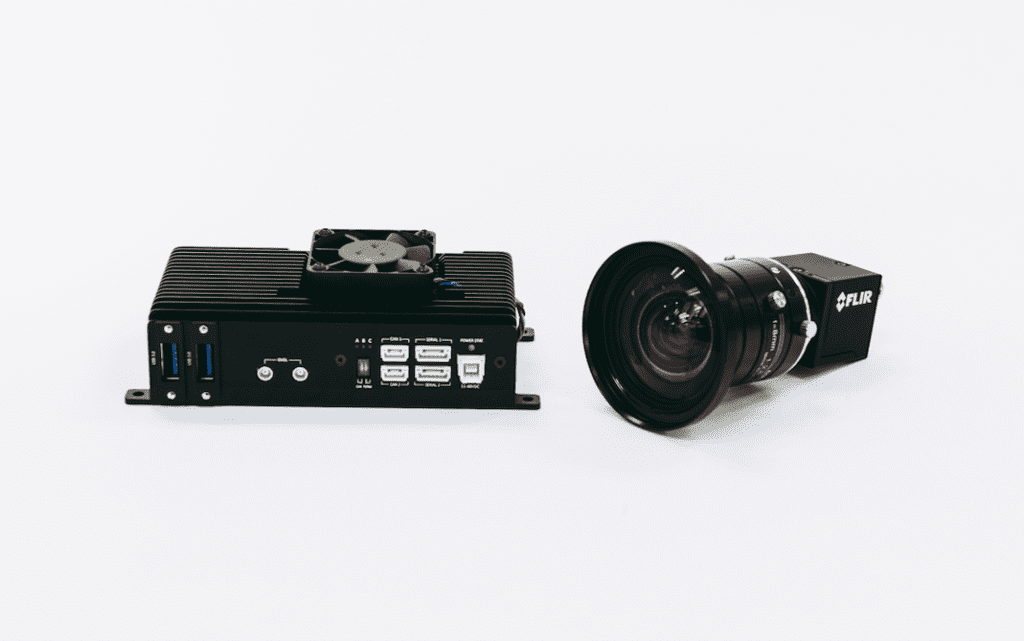
The Casia Long Range Detect-and-Avoid system will be used on the UAS BVLOS flight. (Iris Automation)
Iris Automation, a computer vision technology company making detect-and-avoid (DAA) capabilities for drones, is joining the World Economic Forum’s Global Innovators community, according to a Feb. 9 press release.
“Amid major global disruptions brought about by the COVID-19 pandemic, it is a critical moment for innovative companies to bring forward new ideas to help protect lives and livelihoods of communities and industries around the world,” Timothy Reuter, Head of Aerospace and Drones at the World Economic Forum, said in a press statement. “The integration of unmanned air systems can positively impact vaccine logistics supply chains and other public health needs, but only if performed safely. We look forward to having Iris Automation contribute to our pursuit of solutions leading to these kinds of positive societal outcomes.”
Iris Automation will partner with the Drone Innovators Network (DNI) by supporting projects it is working on and advancing progressive air safety policy frameworks, according to the release.
“Scaling the use of un-piloted aircraft promises tremendous economic and societal benefits,” Jon Damush, CEO of Iris Automation, said in a press statement. “We are thrilled to work with the World Economic Forum’s Global Innovators Community to share ideas and drive thoughtful solutions that address the pressing needs of our time.”
Connectivity
Collins Orders $11 Million in Connectivity Equipment from Astronics
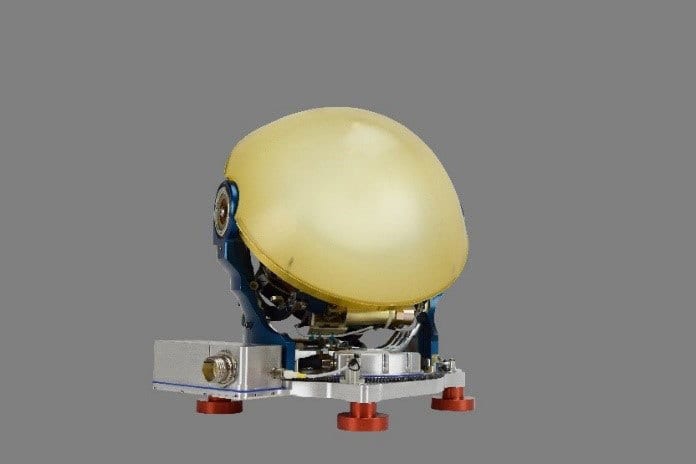
(Astronics tail-mounted connectivity antenna. Business Wire)
Collins Aerospace placed an $11 million order for business jet connectivity equipment from Astronics Corporation, according to a Feb. 10 press release. This order is a continuation of previous orders placed by Collins.
“We are excited to extend and expand the relationship with Collins Aerospace to provide best-in-class connectivity equipment for their customers,” Michael Kuehn, Astronics CSC President, said in a press statement. “We believe this order validates the success of Collins Aerospace connectivity services and the performance of Astronics connectivity hardware. Improved connectivity for the business jet market has become an imperative and we are committed to providing the best connectivity capability available for aircraft with our technologies.”
AeroLogic Implements SITA eWAS Pilot
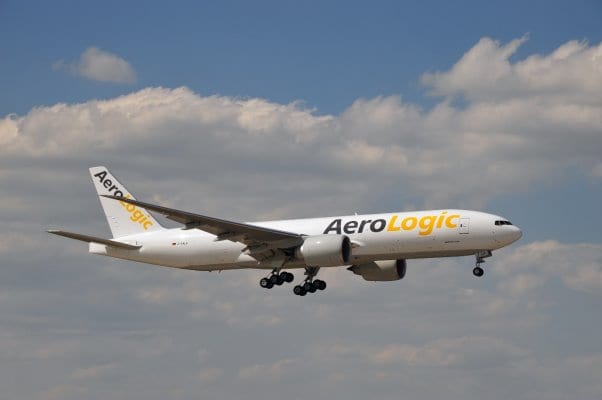
AeroLogic is upgrading its electronic flight bag and cockpit connectivity technology under a new agreement with SITA.
AeroLogic has begun implementing SITA’s weather monitoring solution, eWAS Pilot, according to a Feb. 11 press release. SITA’s eWAS Pilot uses 4D weather forecasts and provides real-time updates about hazards, according to the release.
“Safe, efficient and sustainable operations are a key part of AeroLogic’s long-term strategy, and COVID-19 has accelerated our digital transformation plans to deliver cost and time savings,” Joe Moser, managing director of AeroLogic, said in a press statement. “We selected SITA to help us achieve this because of their industry knowledge and proven solutions. eWAS Pilot helps our crews stay a step ahead, avoiding the avoidable and delivering more efficient flight paths and better fuel usage.”
AeroLogic, a joint venture between DHL and Lufthansa Cargo, operates around 12,000 international flights per year. The eWAS technology was rolled out to the airline’s fleet of Boeing 777 aircraft. SITA is also providing a suite of integrated applications designed to centralize and manage their air to ground communications, Aircom Cockpit Services, to the AeroLogic fleet.